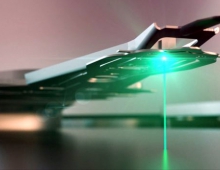
Hitachi HDD Technology Achieves a Storage Density 2.5 Terabits Per Square Inch
Hitachi, Ltd. announced that it has achieved a storage density of the 2.5 terabyte per square inch on a hard disk drive by applying a new technology in the magnetic head of the system.
The new density is five times higher than the one currently met in commercial HDDs.
Hitachi's technology is based on the thermally-assisted recording concept, in which magnetic grains can be made smaller while still resisting thermal fluctuations at room temperature.
As the name suggests, thermally-assisted recording uses a laser to heat up the media while the magnetic head is writing the smaller bits of data. This enables the use of media that is magnetically stable at room temperature with the very small magnetic grains required for high-density storage.
Hitachi has developed a thermally-assisted magnetic recording head assemply comprising of a light source module and a magnetic recording head. The basic feature of the ssytem is light source module, which outputs a ultra-small light beam with a diameter of just 20nm or less.Hitachi said that by using an appropriate disk medium, the system can form bits of 28nm width and 9nm length - enough to ensure stable recording The size of the formed bit is equivalent to a recording density of 2.5 terabits per square inch.
Progress in the hard disk drive industry has most notably been tied to the exponential growth in areal density and the ensuing increases in capacity and reductions in bit cost ($/GB). HDD manufacturers have to keep on ramping up capacity to keep a cost/GB advantage over the oncoming flash memory technology. Physics predicts that today?s conventional continuous-film perpendicular magnetic recording is approaching a fundamental limit of around 1 Tb/in2. As a result, new technologies are required to extend magnetic recording.
Significant R&D is being spent on several new techniques, including discrete track recording, bit-patterned recording, energy-assisted recording such as the one Hitachi has annoucned today, and shingled magnetic recording. Each of these new technologies promises gains in areal density but each has its own challenges that must be overcome to enable them to be introduced into mass production, meaning in high volume with acceptable reliability and performance and at minimal incremental cost.
Energy-assisted recording media may be much too expensive and the cost/GB of flash memory could cross over that of disk in a very few years. If the short write life problem and relaibility of flash media be overcome, flash drives will most probably make significant inroads into data centres, putting HDDs aside.
Hitachi's technology is based on the thermally-assisted recording concept, in which magnetic grains can be made smaller while still resisting thermal fluctuations at room temperature.
As the name suggests, thermally-assisted recording uses a laser to heat up the media while the magnetic head is writing the smaller bits of data. This enables the use of media that is magnetically stable at room temperature with the very small magnetic grains required for high-density storage.
Hitachi has developed a thermally-assisted magnetic recording head assemply comprising of a light source module and a magnetic recording head. The basic feature of the ssytem is light source module, which outputs a ultra-small light beam with a diameter of just 20nm or less.Hitachi said that by using an appropriate disk medium, the system can form bits of 28nm width and 9nm length - enough to ensure stable recording The size of the formed bit is equivalent to a recording density of 2.5 terabits per square inch.
Progress in the hard disk drive industry has most notably been tied to the exponential growth in areal density and the ensuing increases in capacity and reductions in bit cost ($/GB). HDD manufacturers have to keep on ramping up capacity to keep a cost/GB advantage over the oncoming flash memory technology. Physics predicts that today?s conventional continuous-film perpendicular magnetic recording is approaching a fundamental limit of around 1 Tb/in2. As a result, new technologies are required to extend magnetic recording.
Significant R&D is being spent on several new techniques, including discrete track recording, bit-patterned recording, energy-assisted recording such as the one Hitachi has annoucned today, and shingled magnetic recording. Each of these new technologies promises gains in areal density but each has its own challenges that must be overcome to enable them to be introduced into mass production, meaning in high volume with acceptable reliability and performance and at minimal incremental cost.
Energy-assisted recording media may be much too expensive and the cost/GB of flash memory could cross over that of disk in a very few years. If the short write life problem and relaibility of flash media be overcome, flash drives will most probably make significant inroads into data centres, putting HDDs aside.





















